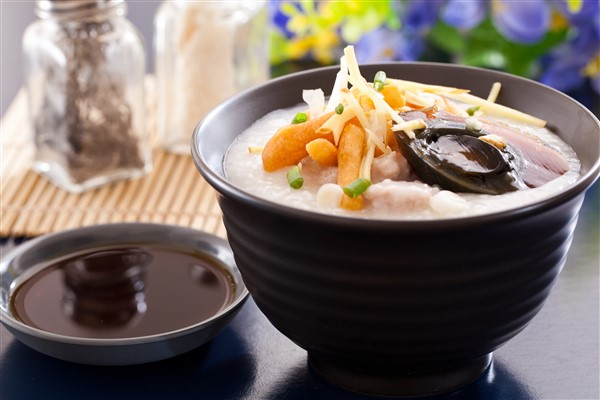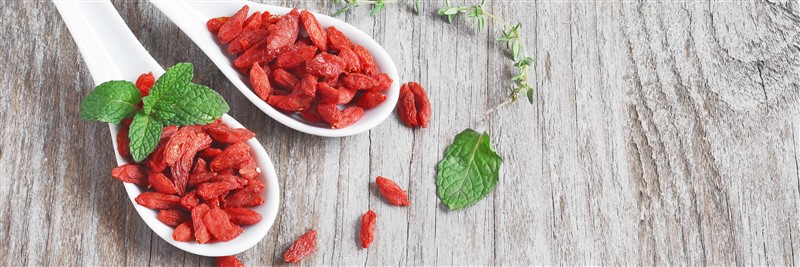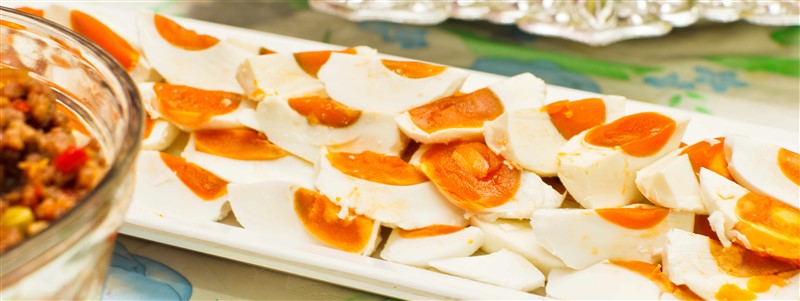12 Congee Toppings and Accompaniments That Will Blow Your Mind
By Charlotte Schell | 14 min. read 

Have you ever tried a bowl of congee with some delicious yet unfamiliar Chinese toppings or accompaniments? If you have, you know the inexpressible feeling of distinct flavors clashing yet mashing into something that’s superior to anything you’ve experienced before. A spoonful of hot creamy congee with a couple cold and refreshing cucumber slices takes you to a whole other world.
You may start asking questions such as: What goes well with different types of congee? What are toppings? What are congee accompaniments? What should I add to flavored congee? How about plain rice congee?
With our complete list of 12 toppings and accompaniments to enhance the taste of congee, we’ve got you covered.
What is Congee?
Before we dive in and talk about all the different topping and accompaniments for congee, you may wonder what exactly congee is and what the different types of congee are. Well, let’s discuss this first.
Congee is an important branch of Cantonese culinary culture. It is often referred to as a type of Chinese rice porridge as the majority of congee recipes use different types of rice as the main ingredient. As the leading force in southern Chinese culinary cuisines, Cantonese congee is primarily known for their wide variety of savory congee recipes and their smooth, creamy texture. Meanwhile, plain rice porridge is actually a country-wide household regular breakfast.
Ingredients are Key
When it comes to the quality of their delicacies such as congee or rice porridge, Chinese people are highly demanding. Since ancient times, gourmet food has strived for excellence in aroma, taste, and presentation. The moment a bowl of soft and creamy congee is laid on the table, its fragrance fills the air. Wafting through the nostrils, the odor enters the body and leaves diners infatuated. Its color and luster is a feast for the eyes, and the first glimpse is enough to attract serious attention. Once it enters the mouth, passing the lips and teeth, it activates the taste buds. Then it moves down the throat, its rich aftertaste lingering, leaving the gourmand wanting more...
For a good bowl of congee, ingredients are key. To achieve a true feast for all the senses, a base of quality ingredients is needed, along with a number of other toppings and accompaniments to enhance the flavor. These Chinese congee toppings and accompaniments cannot be overlooked. They are perhaps unremarkable ingredients, and yet they allow the congee's rich aroma to fill the air. They can turn an ordinary bowl of congee into a lively, fragrant meal, filling your stomach and satisfying your desire for the finest of foods. Common toppings for Cantonese congee include cilantro, Chinese chives, scallion, dried shrimp, ginger, orange peel, celery, and goji berry. Common accompaniments include a wide variety of congee side dishes, salted duck eggs, century eggs, and Youtiao (Chinese fried dough).
Congee Toppings
First of all, let’s clarify a little bit of the terms we will be using throughout this guide. The toppings we are referring here are some of the essential seasoning ingredients that are often added towards the end of Cantonese congee making process, or on top of the congee just before serving. They are meant to enhance the flavors of the main congee ingredients such as chicken, fish, pork and different kinds of seafood together with the rice broth. At the same time, the beautiful colors of these toppings also add to the visual appeal of our already flavorful congee recipes.
Traditional Congee Toppings
There are five traditional congee toppings that you can pretty much see in every savory Cantonese congee recipe. In fact, topping such as coriander, garlic chives, fresh ginger, and scallion can be seen in almost all Chinese porridge across the country. Not only in rice porridge recipes, but these four are also essential seasoning ingredients in nearly all eight traditional Chinese culinary traditions.
1. Coriander
Coriander is used in soups, main Chinese dishes, and congee recipes. Traditional Asian food therapy uses its heavy taste to increase appetite, and Chinese herb medicine utilizes coriander to dispel depression, and relieve pain. If your congee is too bland, you can use coriander to give it a kick. Coriander is the most common seasoning ingredient in making Cantonese congee. The perfect example is the chicken congee with scallops recipe in our Congee section.
2. Garlic Chives
Garlic chives dispel cold, disperse blood stasis, enhance physical strength, and increase appetite according to Chinese medicine. Garlic chives are sweet and become aromatic when heated. Their sweet flavor is easily absorbed by congee. They are best used together with mild-flavored ingredients when making congee. Cantonese seafood congee, for example, tastes great with garlic chives.
3. Dried Shrimp
Dried, shelled shrimp is a popular seafood ingredient with high nutritional value. It can supplement the kidney, invigorate yang energy, rectify qi, and increase appetite. When using dried, shelled shrimp for making rice congee, first soak the dried shrimp in warm water, and then add both the water and the dried shrimp to the congee together, creating a Cantonese congee base with a fresh flavor. Dried, shelled shrimp is high in protein, and packed with other nutrients. Frequently consuming congee with dried shrimp in it can improve one's complexion and not to mention the plethora of flavors in the bowl.
4. Fresh Ginger
Fresh ginger removes toxins, destroys bacteria, and deodorizes. Consuming the gingerol contained in fresh ginger produces an antioxidase with powerful antioxidant properties. Ginger can also fortify the stomach, relieve pain, and dispel heat based on herbal remedies. While some choose to sprinkle them on top of a bowl of congee, it is often shredded and used as a seasoning or used to marinate fish and meat. In this way, it gives the congee appetite-increasing properties. No wonder they show up frequently in all congee recipes!
5. Scallion
Scallion is often referred to as green onions in some of our recipes. Consuming scallion provides antioxidant effects and boosts the immune system. Consuming both the green and white parts of scallion help treat wind-cold common colds. It also induces sweating and resolves heat. Scallion is a favorite ingredient of Cantonese chefs. They can be added to congee, soup, or noodles to enhance flavor and increase appetite.
Vegetarian Congee Toppings
While the traditional congee toppings are also widely used in vegetarian congees as well, there are a few toppings that are more often utilized in the delicious vegetarian recipes. However, the three listed below are by no means exclusive for vegetarian lovers. In fact, Cantonese chefs often add them into delicious meat congee when it makes sense. Another difference with vegetarian toppings is that ingredients such as tangerine peel and celery are often added throughout the cooking process and boiled together with the rice congee itself instead of being added towards the end like traditional toppings.

1. Dried Tangerine Peel
Using tangerine peel not only enhances the flavor of a dish, but it can also help alleviate an upset stomach and relieve cough symptoms. Many readers of Unfamiliar China are familiar with our tangerine-flavored beef balls (Ngao Yuk) recipe in Dim Sum section. When added to sweet congee, tangerine peel enhances sweetness without making the dish too sweet. It also lubricates the lungs and alleviates coughing. Eastern culture believes that when tangerine peels are used in Chinese congee dishes, it can prevent the effects of aging on one's skin and quicken one's metabolism. As a result, tangerine peel has been an indispensable ingredient in Hong Kong congee dishes that promote health. However, keep in mind that cold water must be used when soaking tangerine peel. Soaking it in hot water will make it bitter, thus causing it to lose its original flavor.
2. Celery
Celery is high in fiber. When digested, it produces an antioxidant that is either lignin-based or intestinal fat-based. Frequently consuming celery – especially its leaves – helps prevent hypertension, arteriosclerosis, and related conditions. Celery also produces auxiliary therapeutic effects. In addition, consuming celery helps prevent heart attack and stroke, and helps treat psoriasis. A little unknown fact, celery grown in Hong Kong is a little bit different from western celery, but western celery is a perfect substitute when Hong Kong celery is not available.
3. Goji Berry
Goji berry helps prevent aging, and thus one of the names for the fruit in Chinese refers to its anti-aging property. Goji berry also improves liver function and protects the eyes. Its natural, light, sweet flavor makes it perfect for healthier congee variations. It is a common ingredient in these kinds of recipes. Goji berry must be soaked until it softens in warm water before being boiled. This helps remove any soil on the berry's surface and promotes the release of its flavor. Congee with Chinese yam and goji berries is just one of the many delicious recipes we have available under Vegetarian Congee.
Toppings Based on Types of Congee
Savory Cantonese Congee
The eight congee toppings mentioned above are often ingredients used in savory Cantonese congee. They are essential parts of these rice congee recipes and their ultimate flavors. In order to make the best congee, it is critical to include them based on the instructions of the recipe, especially for beginners. We call them toppings as they are often the finishing step in the congee making process and sprinkled on top. More accurately, they are also the seasoning ingredients in savory congee recipes.
Plain Rice Congee or Porridge
When it comes to toppings, the story is a little bit different for plain rice congee or Chinese rice porridge. While the rice porridge itself is quite different between northern China and the south, with the southern versions (such as Cantonese plain congee) being a lot creamier and thicker, people across China like to add flavored toppings onto their plain congee. Some of the top choices are roasted peanuts, pickled ginger slices, salted duck eggs, century eggs and fermented vegetables.
Other Congee/Porridge Accompaniments
People often ask the question “What goes well with congee?”
Porridge, in general, is considered a staple food in both China and other Asian countries, and Chinese are known to accompany their other staple foods such as rice or noodles with all kinds of astonishing dishes which later formed the world-famous Chinese cuisines. Why wouldn’t they have some porridge accompaniments?
The answer is: indeed, they do!

1. Congee Side Dishes
Compared to exquisite main dishes in Chinese cuisines, congee side dishes are simple pairings that are packed with flavors. As an iconic comfort food, people often revert to congee when they would like something simple, light, yet flavorful. Accompanied by some cold dishes such as sesame seaweed salad, or some stir-fries such as green chili and dried shrimp stir-fry, one can fully enjoy the original flavors of fresh congee and its savory ingredients yet still has the option to spice things up a bit if so desires. If you ever feel like changing things up a little bit, try one of our simple congee pairing dishes. We have an extensive collection of 25 delicious pairing dishes under Congee section.
2. Salted Duck Eggs
Salted duck eggs are preserved eggs made by soaking duck eggs in salt-water brine for 30-40 days or packing them in salted charcoal. The egg whites are extremely salty after this process and often consumed together with plain rice porridge in China, while the egg yolks are prized delicacies. Well-made salted egg yolks are golden orange in color, savory and creamy in flavor. They are often used in Chinese mooncakes as a filling and some dim sum custard buns recipes also utilize them as filling ingredients. Our heavenly succulent carrot custard buns recipe is one of these yummy treats. Salted duck eggs are often halved when served as a congee accompaniment to show the beautiful egg yolk engulfed by salty egg whites.
3. Century Eggs
Century eggs are another popular porridge accompaniment. In fact, diced century eggs often serve as a popular topping in Cantonese congee, sometimes even as a critical ingredient in some recipes such as pork and century egg congee. As another type of preserved egg, both the overall appeal and flavor are quite distinct from salted duck eggs. Through the preserving process, the egg white becomes a translucent dark brown jelly while the egg yolk becomes dark green in color with strong unique flavors. Many Chinese love it, but it can certainly be an acquired taste and is among many westerners’ feared food list next to chicken feet. However, when listing the top choices for rice porridge accompaniments, one cannot omit the century eggs!
4. Youtiao (Chinese Fried Dough)
As one of the few rare favorites shared by both northern Chinese and southern Chinese, youtiao is a typical breakfast item. Not surprisingly plain rice congee is another shared love among Chinese across different regions. There are many names for youtiao, such as Chinese fried dough, Chinese fried churros, Chinese oil stick, and Chinese doughnut. Deep-fried in oil, authentic youtiao are golden brown and crispy outside with a soft slightly salty dough inside. They are often consumed with plain rice congee in the morning. Another popular option is to have freshly fried youtiao with some hot sweet soy milk. The overall experience is indescribable in nature.
Now you’ve reached the end of our guide for the 12 must-known topping and accompaniments to enhance the taste of congee. Here at Unfamiliar China, we certainly have learned a lot through the writing and researching process. Hopefully, you have a better understanding of how to make better congee in general and some of the intricacies behind it.
You may also like: